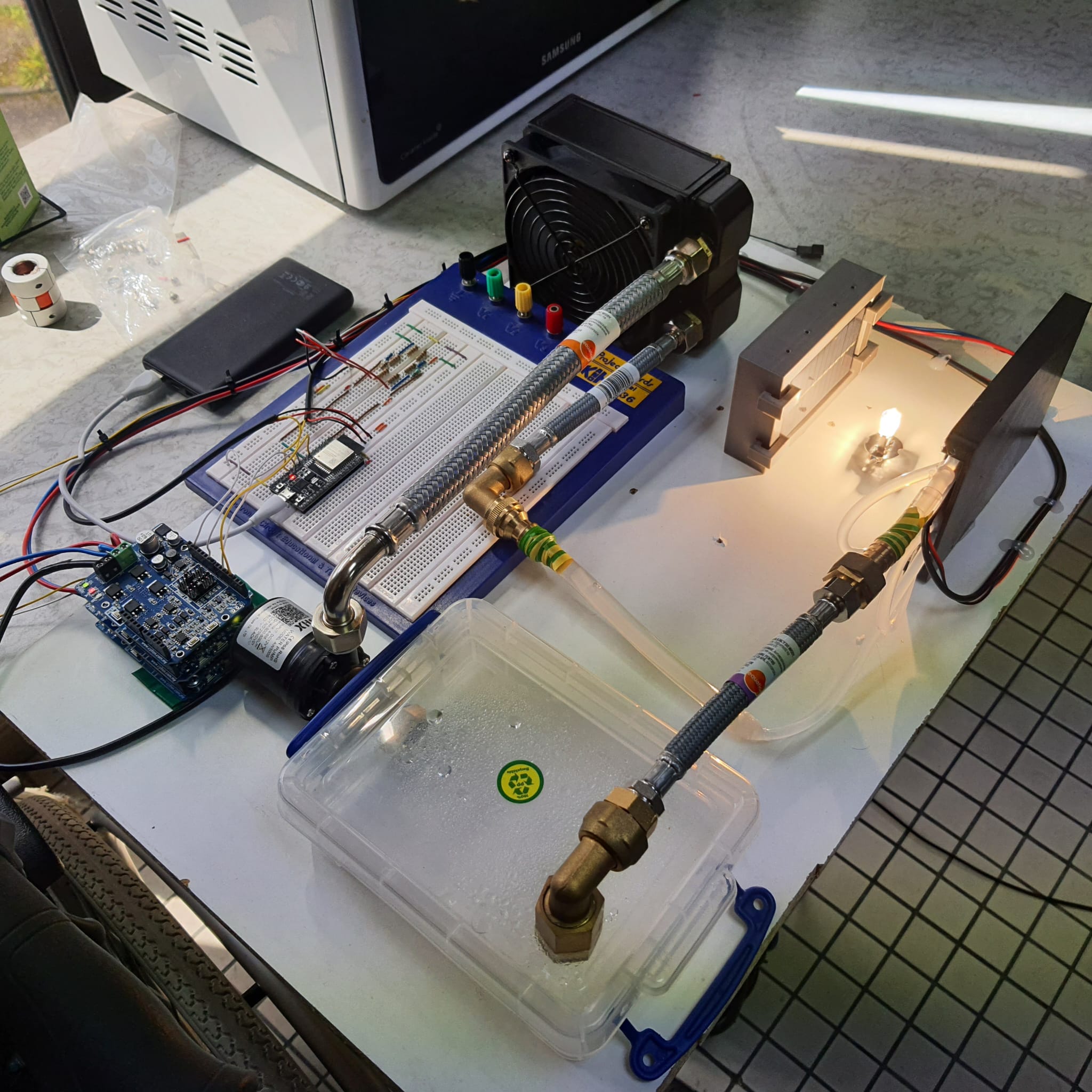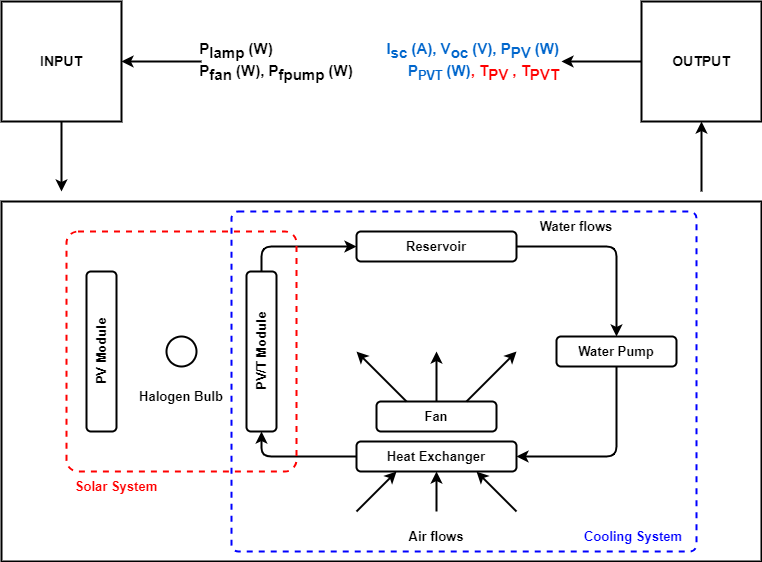EduSolar

Description
Smart Solar Energy Monitoring and Control Experiment Kit is designed for efficient monitoring and control of solar energy systems. This kit is integrated with various sensors and motors using ESP32 microcontroller. The system is equipped with temperature sensors, solar panels, and various loads (pump, fan, lamp). ESP32 microcontroller provides data communication via WiFi and MQTT protocol. Temperature measurement is made from two different points using DS18B20 temperature sensors. Energy production is monitored by measuring the voltage of two solar panels, and energy efficiency is calculated by measuring the current from the solar panels. The speed and brightness of the pump, fan, and lamp are controlled using PWM signals. Data is sent and received via the cloud server, enabling remote monitoring and control. Data communication is made over the internet by connecting to the wireless network with the ESP32's internal WiFi module. This kit can be used to monitor and optimize the performance of solar systems. In smart agricultural applications, environmental conditions can be managed with pump and fan control in cases requiring temperature and humidity control. It also provides control of various electrical devices to monitor and manage energy consumption in the home. The ESP32 microcontroller has a 240 MHz dual-core processor, WiFi, and Bluetooth support. DS18B20 temperature sensors can measure temperatures between -55°C and +125°C. Solar panel voltage measurement has the capacity to read analog voltage between 0-3.3V. Current calculation is made in mA using a 360-ohm current measurement resistor. PWM control provides speed and brightness adjustment of loads with PWM values between 0-255. HiveMQ cloud server offers a secure connection with an SSL certificate over port 8883. In order for this kit to work properly, it is necessary to ensure that the connections are made correctly. If any problem is encountered, the problem can be detected by checking the error messages on the serial monitor.
Objective
The Smart Solar Energy Monitoring and Control Experiment Kit is designed to enhance the efficiency of solar energy systems by providing real-time monitoring and control. It integrates various sensors and motors with an ESP32 microcontroller for comprehensive system management. The kit aims to optimize solar energy performance and ensure effective energy consumption. Its primary objective is to facilitate remote monitoring and control via cloud connectivity.
Method
The kit uses an ESP32 microcontroller to connect sensors and motors for monitoring and controlling solar energy systems. Temperature is measured from two points using DS18B20 sensors, while solar panel voltage and current are measured to monitor energy production and efficiency. PWM signals are employed to control the speed and brightness of various loads such as pumps, fans, and lamps. Data communication is achieved through WiFi and MQTT protocol, with information sent and received via a cloud server.
Practical Applications
The Smart Solar Energy Monitoring and Control Experiment Kit is designed for diverse applications across residential, agricultural, and renewable energy sectors. In smart agriculture, this kit enables precise environmental control by managing temperature and humidity through pump and fan operations, ensuring optimal conditions for crops or livestock. In home energy management, it provides real-time monitoring and control of devices such as fans, pumps, and lamps, enabling users to optimize energy consumption and reduce electricity costs. The ability to remotely monitor solar panel performance and system efficiency makes it ideal for maintaining small-scale solar energy installations, ensuring maximum energy yield. Additionally, the integration of cloud communication and remote control makes it highly suitable for research and educational purposes, where users can explore IoT applications in renewable energy systems.
Key Features
The experiment kit is equipped with a range of advanced features for efficient monitoring and control of solar energy systems. At its core is the ESP32 microcontroller, with a 240 MHz dual-core processor, built-in WiFi, and Bluetooth, providing robust connectivity and computational power. The kit includes DS18B20 temperature sensors capable of measuring a wide temperature range (-55°C to +125°C) from two points, offering precise temperature data for environmental monitoring. Solar panel voltage and current measurements provide insights into energy production and efficiency, with the voltage range up to 3.3V and current measured using a 360-ohm resistor. PWM control enables precise adjustment of the speed and brightness of various loads, including pumps, fans, and lamps, with PWM values ranging from 0 to 255. Data is securely communicated via the MQTT protocol over an SSL-certified connection through HiveMQ’s cloud server, ensuring reliable remote monitoring and control. These features make the kit versatile, scalable, and easy to integrate into IoT-based energy systems.
Learning Outcomes
Participants using this kit will develop a deep understanding of solar energy system monitoring and control, gaining hands-on experience in working with IoT-enabled hardware and software. They will learn to measure, analyze, and optimize solar panel performance, including energy production and efficiency, by interpreting voltage and current data. By configuring and tuning PWM-controlled devices, such as pumps, fans, and lamps, participants will explore the principles of load management and energy optimization. The use of the MQTT protocol and cloud communication teaches practical skills in remote data communication and secure IoT system design. Additionally, troubleshooting using error messages on the serial monitor enhances problem-solving skills. Overall, users will gain technical expertise in renewable energy systems, IoT protocols, and real-world energy management, preparing them for careers in sustainable technology and smart systems.
Functional In/Out Diagram

The functional diagram above illustrates the main components of the system and their interactions:
Input: The system's input comprises the energy supplied to various components to simulate and monitor the performance of the solar and cooling systems. This includes the power supplied to the halogen bulb (Plamp) to simulate sunlight for the PV and PV/T modules, and the power consumption of the cooling system components, such as the fan (Pfan) and the water pump (Pfpump). These inputs drive the solar energy generation and cooling processes, enabling the system to replicate realistic operating conditions for energy and heat transfer experiments.
Process: The central process involves two interconnected systems: the solar energy system and the cooling system. In the solar system, the halogen bulb provides simulated solar irradiance to the PV module and the PV/T module. The PV module converts light energy into electrical energy, while the PV/T module performs both photovoltaic energy conversion and thermal energy management by integrating cooling mechanisms. In the cooling system, the heat generated by the PV/T module is managed through a heat exchanger. The heat exchanger transfers excess thermal energy to a cooling medium, which is circulated through a water pump and stored in a reservoir. A fan ensures air flow across the heat exchanger, enhancing heat dissipation. Together, these processes optimize the energy output of the solar modules while preventing overheating, demonstrating the principles of combined photovoltaic and thermal systems (PV/T).
Output: The outputs of the system are key performance indicators that reflect the efficiency and functionality of both the solar and cooling systems. These include the short-circuit current (Isc), open-circuit voltage (Voc), and power output of the PV module (Ppv), which indicate the electrical energy generation of the solar system. For the PV/T module, the outputs also include the thermal power output (Ppvt) and the temperatures of the PV/T system (Tpv, Tpvt), which provide insights into the thermal management efficiency. Together, these outputs enable the assessment of the energy conversion efficiency and the effectiveness of the cooling system in maintaining optimal operating conditions for the PV/T module.
Posted on 2024-12-04 15:58:43
We’ve added a new "Smart Solar Energy Monitoring and Control Experiment Kit" to enhance your solar energy system’s efficiency. This kit features various sensors and motors integrated with an ESP32 microcontroller, offering remote monitoring and control capabilities. Start optimizing your solar energy performance today!